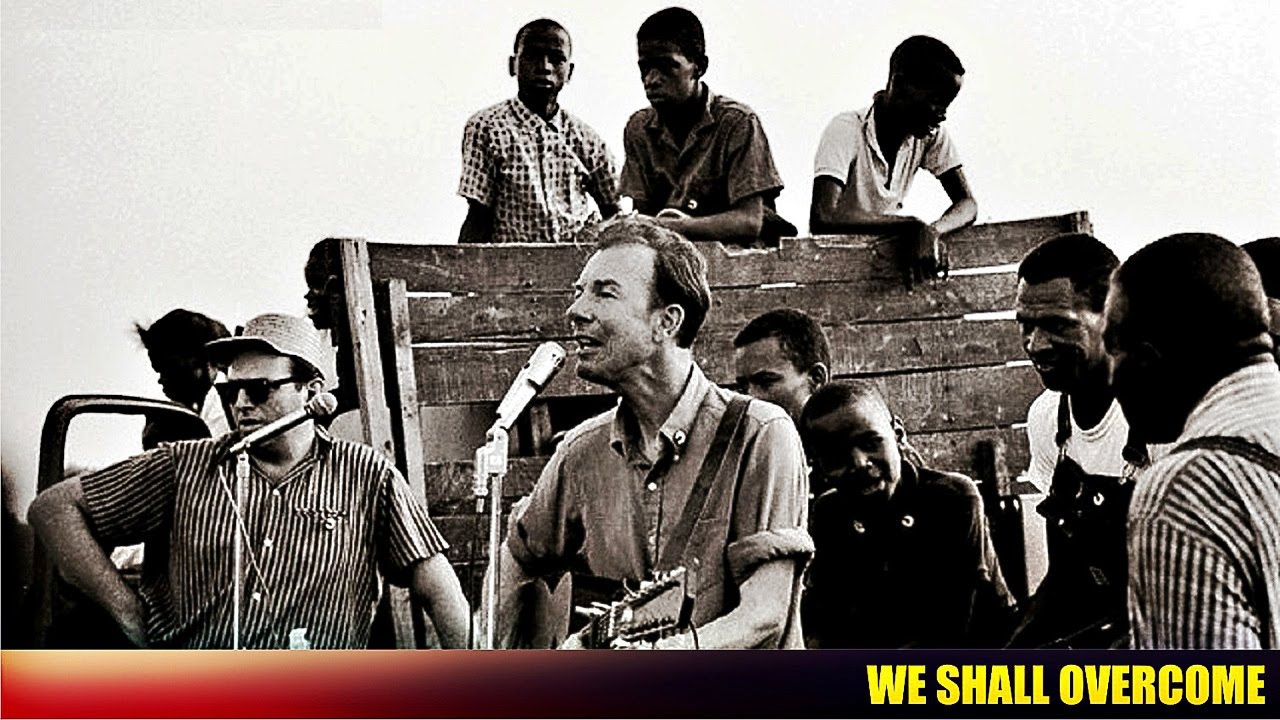What’s Wrong with Copyright and How to Fix It
You might have stood in a protest group singing “We Shall Overcome.” Until this week, you might have stood in violation of copyright. The first published version dates from 1900, but with slightly different lyrics. That puts its composition too far back in time to qualify for copyright protection.
Even so, given today’s dysfunctional legal system, deep pockets can claim “ownership” of any kind of pool of information, and get away with it. That’s exactly what happened: The Richmond Organization demanded royalties on the song from a filmmaker trying to use this American classic. Litigation has been brutal and expensive.
In reality, the tune has been in the public domain for hundreds of years, as Catholics who have sung “O Sanctissima” know. The song draws from musical motifs that are part of a multi-generational common culture of religious/folk music. So it has been bizarre to watch the struggles over who “owns” the song. Finally, the litigants settled last week because the expense associated with enforcing the claim far exceeded whatever royalty revenue might otherwise have been earned for the main claimant.
A similar situation occurred with the song “Happy Birthday.” Until very recently, commercial establishments have been intimidated into not singing it for fear of the copyright police. The Warner Music Group claimed to own and control it. The company raked in millions every year.
In the music world, if you can find an edition of words and music on an edition published before 1923, the music in question is considered by the legislation to be part of the commons. This convention came about with the Sonny Bono Copyright Extension Act of 1998, or better known as the “Mickey Mouse Protection Act.” It was a blatant case of industrial protection, forcing copyright on all works for the lifetime of the claimant, plus 70 years.
“Happy Birthday” has been part of popular culture dating back to the 19th century. The melody is well documented as “Good Morning to All” and appeared in songbooks. What really happened is that a mega-big corporate monopoly pillaged the commons and took exclusive possession of a non-scarce good, solely to gain monopoly rents.
And this is precisely what happens when you have a blunt instrument like the state available to take up the cause of a would-be industrial monopolist. This is precisely the case with patent and copyright. They were not instances of government coming to the service of previously agreed-upon contractual rights and clams. They were cases of government creating legal rights for private parties to deploy coercion against competitors by asserting ownership where none can truly exist.
Yes, I know that these two institutions trace their American origin far back in history. The founders thought they would improve on European practice by removing the exclusive rights to own information from the state as such and devolving it to individuals. It seemed like an improvement. But the state was still left to define and enforce the rules.
The original copyright law of 1790 pertained to books, maps, and charts for 14 years, renewable for another 14 years. It only applied to US works, but there was no international copyright, which accounts for why British literature was the staple curricula for American school kids in the 19th century. It was cheaper to print and distribute without the royalty tax.
Protection became internationalized in the late 19th century, but domestic terms were left in place. Then came 1976, when copyright became automatic for the life of the author for all published and unpublished works. In other words, according to US law, at least in principle, I can scrawl a shape on a napkin and then sue my neighbor for accidentally scrawling the same.
This law kept being amended to the point that huge libraries of books and music published in the 20th century fell into a vortex of confusion. Even now, we are missing tens of thousands of books from digital access due to copyright disputes. Not all works are orphaned. Most have “owners” who don’t care enough to do something about it. But when you contact them about rights, they suddenly see dollar signs flashing before their eyes.
As a publisher, I’ve experienced this dozens of times. Another tragedy is that authors themselves continue to lose control over their own works, simply because the rights to administer copyright belongs not to the creator but the publisher. The effect is hugely demoralizing on the people who do the hard work and then sign contracts they do not understand.
It’s not a surprise: when government sets the rules, strange things happen.
The entire project became unviable in the late 1990s when software became the driving force of economic life. Code requires some means of sharing. Silos of information became unviable. Enforcement became nearly impossible. And it became clear that Congress lacked the intelligence to act in a way to break down barriers. Repeal of what is essentially a very old error was out of the question.
So in 2002, a new project began that used existing law to encourage creators to voluntarily opt out of a coercive structure by contract. The Creative Commons license permitted four forms of options. You can share your work on the condition that the user shares his or her work. You can share but with restrictions on commercial use. You can share contingent on the attribution of the work. Or you can share with no conditions at all.
The American Institute for Economic Research has lent its known prestige and authoritative reputation to the cause by adopting the Creative Commons Attribution license, which enables anyone to reprint and translate (or remix and even sell) our material, provided that they attribute the source. It’s already boosted the reach of AIER’s work dramatically.
Since the advent of Creative Commons, more than a billion works have been emancipated from the prison of conventional copyright as defined by Congress to become useful works in the building of a common culture. Today the digital economy would grind to a halt without the commons. Tellingly, it was this private-sector innovation that made it all possible. Reform from the center became impossible so creators themselves did it.
What sectors have benefited? Publishing, music performance and composition, scholarship, photography, filmmaking, and, really, everyone.
The most common refrain you hear from defenders of old-fashioned copyright is that business can’t work without the imposition of property claims on ideas. Reality shows otherwise. The most in-use operating system in the world for smartphones (Android) is part of the commons and thereby inspired the creation of millions of applications that form the basis of a new global economic infrastructure. Open-source systems drive forward the web. Distributed networks based on open-source software are reinventing money, contracts, and payment systems.
There are many goods over which copyright has never been enforceable, and yet they work just fine. The fashion industry exists without it. Every new design in every season can be copied by anyone. And it happens all the time. The expectation is baked into the sales model. Instead of government-protected monopoly, we get a highly competitive, fast-moving industry that serves all classes and tastes.
Another fascinating case is the perfume industry. Scents cannot be copyrighted and patented. They can all be reverse engineered and sold for a fraction as much as the cosmetic counter and Bloomingdale’s are trying to sell them. This happens every day. And yet, somehow and seemingly miraculously, the industry is gigantically profitable, and plenty of people still pay $100 per bottle — just for the guarantee of quality and the prestige that comes with using the original.
It’s been 18 years since Napster was taken down in the interest of protecting the music monopoly. The takedown did nothing to stop file sharing and piracy. In fact, as a result of it, the industry has come around to see the commercial advantages of sharing. Most artists today put their music up at zero-cost on YouTube, and see commercial sales through advertising, digital purchases of albums and songs, plus performance contracts and swag that come with it.
Indeed, at every stage of technological advance in the music industry, voices of doom warned of the coming apocalypse when new music would be no more. And yet, at every stage — records, radio, tapes, digital file sharing — the result has been the opposite. The industry as a whole is more profitable than ever. And there has never been a time in history when such a variety of music has been available to so many at such low prices.
Copyright was invented in the iron age, and its utility has been systematically undermined in the digital age of ubiquitous information sharing. Nearly every dance party and nightclub in the country (and nearly every individual, for that matter) stands in violation of the law, and everyone knows it. The industry uses the prevailing restrictions and privileges to selectively plunder people whenever they get the chance, sort of like agents from liquor control at the height of Prohibition.
Somehow, the comical scene of servers at restaurants trying to sing something, anything, to celebrate the birthday of customer underscores the absurdity of the entire racket. The collapse of the “Happy Birthday” and “We Shall Overcome” monopoles are giant leaps toward a future without government-created art cartels. Music, research, and writing can be free like speech without being free like beer. There is no incompatibility between the demands of modern commercial life and a culture of sharing; indeed, they depend on each other.
To my mind, Creative Commons is an imperfect solution to a major problem, while the best solution would simply leave the whole problem of production, ownership, and attribution to the market itself. But that is not the world we yet live in. Until then, it’s a beautiful thing that the market has found a stop-gap solution to the intractable problems caused by one-size-fits-all standards of legislative imposition.











